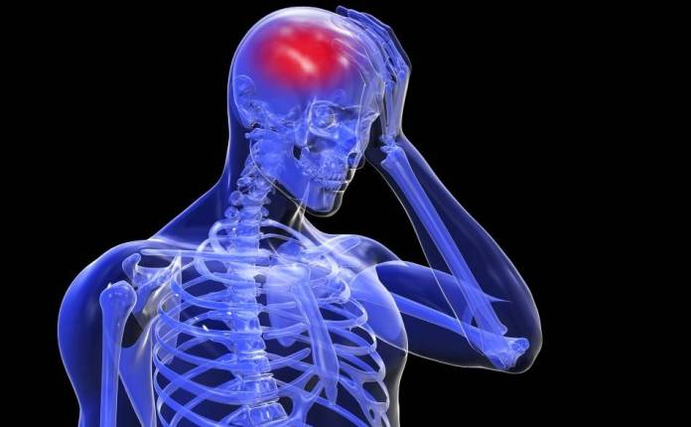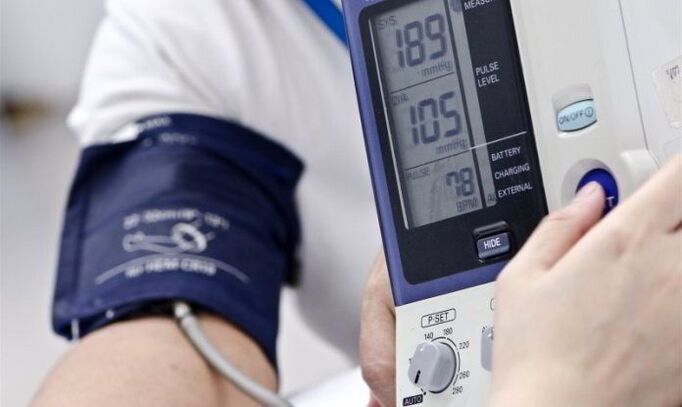Cervical osteochondrosis is a disease of the spine characterized by disorders of intervertebral discs.Pathology is typical of elderly people, but it can meet it any age.Tangible discomfort causes one of the main signs of this disease - severe pain.The patient should know how dangerous the cervix osteochondrosis is and what problems he should face.
The characteristics of the disease
The cervical region is one of the most mobilized parts of the body and is faced with regular loads.With the development of osteochondrosis, the shift of the vertebrae, which leads to compression of many vessels and nerves.The main complexity of pathology is that its distinctive dyspancial changes affect the roots of the spine and the plates of the intervertebral space.As a result, the brain remains without the necessary oxygen and the blood supply is lost.

In the risk zone, there are primarily elderly people in whom the disease develops in the background of metabolism and changes in the structure of vertebrae and intervertebral discs are related to age.There may also be the cause of developing such violations:
- salt deposit;
- insufficient physical activity;
- Inadequate nutrition;
- injuries;
- frequent hypothermia;
- Hormone problems;
- Overweight;
- Chronic diseases.
Osteochondrosis also provokes the long -term presence of the body in one position, which imposes office employees and drivers.
Symptoms of osteochondrosis
At the initial stage of the disease, the symptoms are almost invisible, and anxiety can only cause mild pain in the neck.However, with the development of pathology, the symptoms gradually increase.
Cervical spine osteochondrosis can be identified with the following signs:
- severe pain in the neck, sun, shoulders;
- regular migraine;
- the weakness of the hands;
- Neck mobility is limited;
- When the head is rotated, the vertebrae crumble;
- Hearing problems;
- There is a characteristic ringing in the ear;
- Discomfort in the throat.
In the initial stages, the pain syndrome only occurs during movement when it shakes or turns its neck.Over time, pain occurs when the position of the hands changes.
Potential complications
If the cervix is not treated with osteochondrosis, the degenerative process of the intervertebral plates leads to loss of their main functions and a reduction in density.Excessive mobility of the spine is gradually developed, muscles, joints and ligaments suffer.The pressure on the nerve endings and the spinal cord will only increase, leading to an increase in symptoms and the development of new pathological phenomena.

Frequent migraine
You can calculate headaches to the most common consequences of osteochondrosis of the cervical spine.This is because this is located in the spinal artery, which is responsible for transporting oxygen and blood to the brain.
When changing the strength of the disk, the depreciation functions are violated.The deformed vertebrae press the artery, disturbing blood circulation and the "entry" of the necessary oxygen.Muscle cramps develop.
After the following pain, simultaneous symptoms often follow:
- nausea;
- vomit;
- sharp increase in pressure;
- tingling in the blades;
- Weakness throughout the body.
In the case of severe attacks, it is desirable to relax as much as possible in a better horizontal position.An unpleasant syndrome can remove painkillers or cold compressions while massage is useless.
The problems of vision
Complications of osteochondrosis of the cervix often affect the visual organs: at this stage of the spine there are sleepy and spine arteries that are responsible for the blood flow to the visual central structure.Compression of nerve roots and blood vessels leads to hypoxia and results in a reduction in vision.
Together with spinal artery syndrome, symptoms such as as follows:
- code;
- darkness in his eyes;
- the appearance of "flies" or colored spots;
- branching;
- excessive tension of the optic nerve;
- dizziness;
- nausea.

During the examination, the specialist may notice the narrowing of the eye -retina arterial vessels, less frequently swelling of the optical nerves.In addition, glaucoma may be due to the cause of the disease, with increased intraocular pressure and pain.
Hearing problems
Due to the compression of the spinal artery and nerve roots, hearing loss is 20-30%.Neglected cervix -osochondrosis can result in a complete deaf.To avoid this, contact your doctor for the first symptoms of the disease.
A slight decrease in hearing can be reversed: with a doctor prescribed by a doctor, the patient needs special exercises or massage of ear shells.TV -watching or listening to music is better for a small volume to be better at the hearing organs.
Hypotension or hypertension
The rather common consequences of reduced or increased blood pressure in the cervix osteochondrosis.The biggest danger is hypertension that are characterized by:
- Causation of the pulse;
- increased sensitivity to temperatures;
- sleep disorders;
- nose bleeding;
- dyspnea;
- heartache;
- Sweating.
The higher the blood pressure, the higher the load on the heart, which leads to rapid wear.As a result, heart failure develops.In high blood pressure, atherosclerosis develops faster, which is dangerous for cerebral stroke.
Hypotenia does not pose a direct threat to life, but greatly influences its quality.The body experiences oxygen starvation, which affects the patient's general well.Hypotony is characterized by violation of venous and arterial blood supply, which results in a disorder of the limbs.Possible complications include myocardial infarction.

Plants -Vascular dystonia
Plants -Vascular dystonia is a general name for syndrome that can affect many body systems and organs.The pathology, the cardiovascular system and most peripheral nerves suffer from pathology.The patient experiences constant anxiety and sharp emotional differences.Frequent panic attacks are also possible and the heart rate becomes more frequent.
Symptoms of dystonia can be smeared or disguised as other diseases.In this case, the consequences of osteochondrosis of the cervix region are not the most pleasant.Thus, the stomach system often suffers: nausea and vomiting, diarrhea, constipation and severe abdominal pain are possible.Disorders of the gallbladder or liver are possible.Patients often complain of tachicardia, pressure problems and heartache.
Tuna
In the case of a vertebral hernia, fragments of the plate "reach" or fall out of the spinal canal.The initial phase of this pathology is called prominence.The integrity of the intervertebral disk does not interfere with it, but the spinal canal has a slight protrusion.At this stage, pressure on the roots of the spinal cord, so the main symptom is weak pain during movement.In later stages, the pain syndrome increases.
The mobility of the vertebrae gradually decreases.Muscle tension increases, even if the patient is in a relaxed condition.You can also remember periodic weakness in the top of the hands or in the wrist.The hands of the hands appear and the tingling often occurs near the thumb.
This is what is the hazardous osteochondrosis of the cervix: it has a heavy load on the artery that passes by the spinal column and is necessary for proper blood supply to the brain.If the patient's excessive pressure occurs, ischemic stroke is expected.
A large hernia is dangerous for inflammation of the surrounding ligaments - this is cervical ray.Only timely treatment can prevent complications.The patient should listen to his body carefully and consult a doctor for the first symptoms.Suspicion should be caused:
- A sharp attack of nausea without visible reasons;
- In the face of darkness;
- noise in the ear when he turns his head;
- Pulling feelings in the neck, in a long stay.
The most severe complications are the risk of irreversible paralysis of one or both hands.The brain nerve atrophy leads to this, which is located in the cervical region.If the hernia puts pressure on the blood vessels, they will gradually die, leading to the innervation of many organs.
Vestibular barrel
Vestibular-barrel syndrome is a condition in which the patient experiences a strong dizziness that is accompanied by loss of orientation.
The attacks are thrown up or back with a sharp rise, turning quickly or back.The state of the state is:
- noise in the ear;
- nausea;
- visual impairment;
- The feeling that everything is spinning and floating in front of his eyes.
The main cause of the pathology is the lack of blood supply, which involves the dysfunction of the vestibular device.Syndrome is increasingly common when osteochondrosis develops.
Glorious minute syndrome
The launched osteochondrosis is dangerous with the neuro-vascular disorders of the throat and larynx.Syndrome is characterized by:
- hoarseness;
- Difficulties when swallowing;
- The constant feeling of a coma in the throat;
- drought and pain;
- Complete loss of sound.
The syndrome suddenly occurs and is accompanied by dizziness.
Syndrome Bar Lieu
The second name of the pathology is spinal artery syndrome.The cause of its development is the stenosis of the spinal canal (narrowing), in which the spinal artery cramps as well as the compression of blood vessels and nerves occurs.
Symptoms include:
- hypertension;
- nausea;
- Tachicardia;
- carving in his eyes;
- noise in the ear;
- Loss of coordination of movements;
- Pulsating pain in temples or in the occlital region.
With sharp movement or turning the neck, the patient may lose his consciousness.

Hypothalamic syndrome
At the same time, the hypothalamus suffers from the syndrome - the part of the brain responsible for man's metabolism, pressure, sleep, body temperature and emotional reaction.Functional disorders can be manifested by increasing or weakening the activity of the brain class.In the first case, the patient becomes irritable in the second - inhibited.
Symptoms often resemble Neurasthenia, which is manifested through the following:
- sleep disorders;
- resentment;
- irritability;
- high fatigue;
- Instability of the mood.
One loses the possibility of concentration, and there are problems with memorization.The outbreak of unjustified anger is possible, the appetite disappears and the libido decreases.
It is better to prevent any disease than to treat, and to predict the behavior of osteochondrosis is quite difficult.If there are risk factors, you should regularly perform a simple physical exercise that increases the mobility of the vertebrae and eliminates congestion in the collar area.
Frequent appearance of any of the symptoms described is an obvious sign of the problems that arise.However, self -medication is useless and will not work without consulting a specialist.

















































